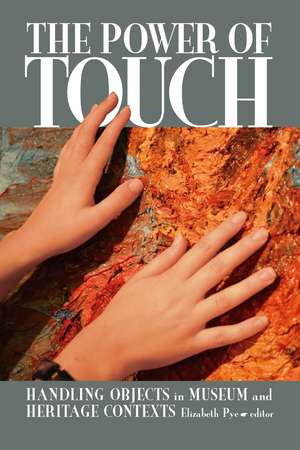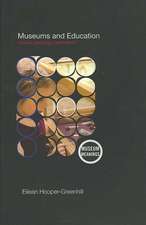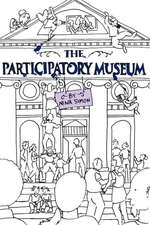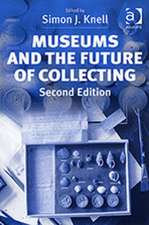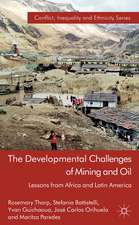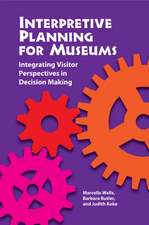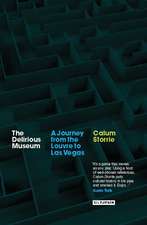The Power of Touch: Handling Objects in Museum and Heritage Context: UCL Institute of Archaeology Publications
Editat de Elizabeth Pyeen Limba Engleză Paperback – 28 feb 2008
Din seria UCL Institute of Archaeology Publications
- 18%
 Preț: 782.47 lei
Preț: 782.47 lei -
 Preț: 413.33 lei
Preț: 413.33 lei -
 Preț: 312.56 lei
Preț: 312.56 lei -
 Preț: 288.80 lei
Preț: 288.80 lei -
 Preț: 349.74 lei
Preț: 349.74 lei - 12%
 Preț: 340.69 lei
Preț: 340.69 lei -
 Preț: 502.75 lei
Preț: 502.75 lei - 31%
 Preț: 765.68 lei
Preț: 765.68 lei - 16%
 Preț: 245.83 lei
Preț: 245.83 lei -
 Preț: 352.41 lei
Preț: 352.41 lei -
 Preț: 364.44 lei
Preț: 364.44 lei - 25%
 Preț: 1022.48 lei
Preț: 1022.48 lei -
 Preț: 386.31 lei
Preț: 386.31 lei -
 Preț: 414.53 lei
Preț: 414.53 lei - 26%
 Preț: 988.16 lei
Preț: 988.16 lei -
 Preț: 384.02 lei
Preț: 384.02 lei - 15%
 Preț: 582.24 lei
Preț: 582.24 lei -
 Preț: 368.76 lei
Preț: 368.76 lei -
 Preț: 345.39 lei
Preț: 345.39 lei - 17%
 Preț: 240.42 lei
Preț: 240.42 lei - 15%
 Preț: 249.80 lei
Preț: 249.80 lei - 26%
 Preț: 1044.60 lei
Preț: 1044.60 lei - 18%
 Preț: 784.67 lei
Preț: 784.67 lei - 29%
 Preț: 1020.09 lei
Preț: 1020.09 lei - 25%
 Preț: 364.86 lei
Preț: 364.86 lei -
 Preț: 349.53 lei
Preț: 349.53 lei - 15%
 Preț: 669.94 lei
Preț: 669.94 lei - 18%
 Preț: 1128.91 lei
Preț: 1128.91 lei - 18%
 Preț: 1082.83 lei
Preț: 1082.83 lei -
 Preț: 395.47 lei
Preț: 395.47 lei - 17%
 Preț: 247.40 lei
Preț: 247.40 lei -
 Preț: 354.71 lei
Preț: 354.71 lei - 19%
 Preț: 241.15 lei
Preț: 241.15 lei - 16%
 Preț: 264.12 lei
Preț: 264.12 lei - 17%
 Preț: 246.84 lei
Preț: 246.84 lei - 26%
 Preț: 1014.74 lei
Preț: 1014.74 lei -
 Preț: 349.05 lei
Preț: 349.05 lei
Preț: 370.87 lei
Nou
Puncte Express: 556
Preț estimativ în valută:
70.96€ • 74.29$ • 58.72£
70.96€ • 74.29$ • 58.72£
Carte tipărită la comandă
Livrare economică 05-19 aprilie
Preluare comenzi: 021 569.72.76
Specificații
ISBN-13: 9781598743043
ISBN-10: 159874304X
Pagini: 262
Ilustrații: 40
Dimensiuni: 152 x 229 x 18 mm
Greutate: 0.48 kg
Ediția:1
Editura: Taylor & Francis
Colecția Routledge
Seria UCL Institute of Archaeology Publications
Locul publicării:Oxford, United Kingdom
ISBN-10: 159874304X
Pagini: 262
Ilustrații: 40
Dimensiuni: 152 x 229 x 18 mm
Greutate: 0.48 kg
Ediția:1
Editura: Taylor & Francis
Colecția Routledge
Seria UCL Institute of Archaeology Publications
Locul publicării:Oxford, United Kingdom
Cuprins
chapter0 Introduction: The Power of Touch, Elizabeth Pye; Part 1 Science of Touch; Chapter 1 Weighing Up the Value of Touch, Alan Wing, Christos Giachritsis, Roberta Roberts; Chapter 2 Making Sense of Touch: A Multisensory Approach to the Perception of Objects, Charles Spence; Part 2 History Of Touch; Chapter 3 Archaeology of Touch: Babylonian Magic and Healing, Mark Geller; Chapter 4 For Your Eyes Only? the Magic Touch of Relics, Jan Geisbusch; Chapter 5 Don’t Touch! Hands off! art, Blindness and the Conservation of Expertise, Fiona Candlin; Part 3 Professional Touch; Chapter 6 Exploring the Role of Touch in Connoisseurship and the Identification of Objects, Sally MacDonald; Chapter 7 Understanding Objects: The Role of Touch in Conservation, Elizabeth Pye; Part 4 Touch and Memory; Chapter 8 The Elderly as ‘Curators’ in North London, Michael Rowlands; Chapter 9 Easing the Transition: Using Museum Objects with Elderly People, Claire Jacques; Part 5 Touch and Memory; Chapter 10 The Touch Experience in Museums in the UK and Japan, Julia Cassim; Chapter 11 Touching Art, Touching You: Blindart, Sense & Sensuality, Sharareh Khayami; Chapter 12 Learning Through Touch, Tara Trewinnard-Boyle, Emily Tabassi; Chapter 13 To Play or Not to Play: Making a Collection of Musical Instruments Accessible, Andrew Lamb; Chapter 14 Collaborative Touch: Working with a Community Artist to Restore a Kwakwaka’wakw Mask, Jessica Johnson; Part 6 Virtual Touch; Chapter 15 Touching Ghosts: Haptic Technologies in Museums, David Prytherch, Marie Jefsioutine; Chapter 16 Exploring Virtual Touch in the Creative Arts and Conservation, Angela Geary;
Descriere
Contributors to this volume explore how the sense of touch can be utilized in museums and other cultural institutions to facilitate understanding and learning.
